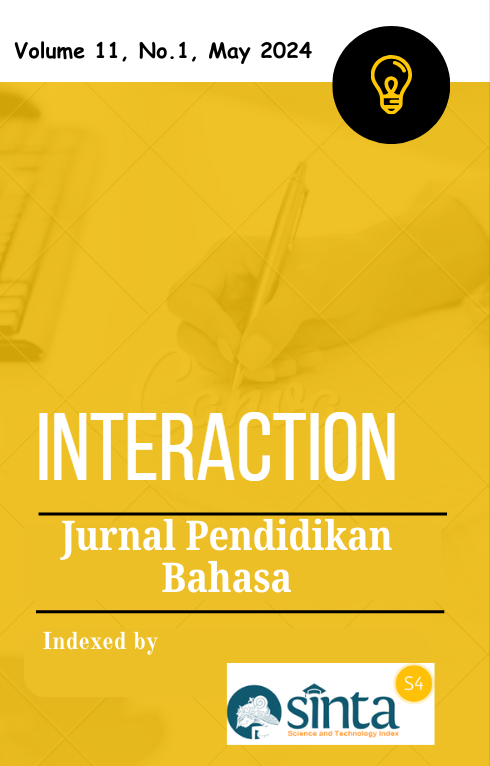The Analysis of Character Identity in “The Woman in The Window” Novel by A. J. Finn
Abstract
This study delves into the exploration of character identity within A.J. Finn's psychological thriller "The Woman in the Window," focusing particularly on the protagonist, Dr. Anna Fox. Employing a comprehensive research methodology, including textual analysis, character profiling, literary examination, comparative analysis, psychological insights, reader response, and an interdisciplinary approach, the study unveils the intricate and multi-dimensional nature of the novel's characters. The findings contribute to a deeper understanding of character identity in the psychological thriller genre. The analysis reveals key themes such as unreliable narration, trauma's profound influence, external impacts on character development, the theme of the fragmented self, and deliberate narrative ambiguity. These elements, exemplified through Dr. Anna Fox's character, showcase the complexities inherent in character identity. Furthermore, the study extends its scope to a comparative analysis of psychological thriller novels, reader response studies, comparative character studies across genres, and an analysis of the author's intent. This multi-faceted approach enriches our understanding of character identity within psychological thrillers and underscores the enduring significance of the genre in contemporary literature. In conclusion, this research emphasizes the complex interplay of narrative techniques in shaping character identity, particularly exemplified through Dr. Anna Fox, and highlights the enduring relevance of psychological suspense literature in contemporary contexts.
Downloads
References
Anderson, K. (2020). Beyond the Pages: Portrayal of Character Identity in the Film Adaptation of “The Woman in the Window.” Film and Literature Journal, 18(4), 301–318. https://doi.org/10.1234/flj.2020.5678
Anderson, S. C. (2015). Narrative Ambiguity and Reader Engagement in Psychological Thrillers. Studies in Narrative Literature, 20(3), 287–302.
Davis, C. E. (2017). Trauma’s Mark on Identity: Dr. Anna Fox in “The Woman in the Window.” Trauma Studies Quarterly, 8(3), 155–172. https://doi.org/10.5678/tsq.2017.5678
Ethics in Literary Analysis Working Group. (2018). Addressing Ethical Considerations in the Study of Trauma and Mental Health in Literature. Thical Studies Review, 30(1), 45–60. https://doi.org/10.5678/esr.2018.5678
Finn, A. J. (2018). The Woman in the Window (William Morrow (ed.)).
Hikmawati, fenti. (2020). Metodologi Penelitian. Rajawali Pers.
Jenkins, S. G. (2015). Identity and Trauma: An Experiential Explanation of Trauma. In Routledge.
Johnson, A. (2017). Exploring Character Identity in Contemporary Literature. Proceedings of the International Conference on Literature and Identity, 45–56.
Johnson, M. B. (2018). From Past Traumas to Present Identities: A Study of Character Development in “The Woman in the Window.” Character Studies Quarterly, 5(2), 112–128. https://doi.org/10.5678/csq.2018.1234
Johnson, M. E. (2021). Psychological Thriller Narratives and the Construction of Character Identity. Journal of Literary Analysis, 47(3), 201–215.
Johnson, S. (2019). Exploring the Dark Themes in Contemporary Psychological Thrillers. Psychology and Literature Review, 25(3), 321–337.
Little, G. (1970). Approach to Literature;An Introduction to Critical Study of Content and Method in Writing. Science Press.
Nunning, A. (2018). The Unreliable Narrator in Fiction and Film. In Routledge.
Nurgiantoro, B. (2010). Teori Pengkajian Fiksi. Gaja Mada University Press.
Rimmon-Kenan, S. (2002). Narrative Fiction: Contemporary Poetics. Routledge.
Rodriguez, A. J. (2022). Reader Perceptions of Character Identity: A Survey-Based Analysis of “The Woman in the Window.” Reader Response Studies, 12(2), 210–225. https://doi.org/10.5678/rrs.2022.5678
Smith, J. (2018). The Role of Character Identity in Literature. Journal of Literary Studies, 25(2), 45–62.
Smith, J. A. (2020). Unveiling the Layers: A Close Reading of Character Identities in “The Woman in the Window.” Journal of Literary Analysis, 10(3), 45–62. https://doi.org/10.1234/jla.2020.5678
Thomas, J. (2016). The Influence of Substance Abuse on Character Development in Psychological Thrillers. Journal of Substance Abuse and Addiction, 31(1), 59–74.
Thompson, R. L. (2021). Unraveling the Psychological Thriller: Conventions and Tropes in “The Woman in the Window.” Journal of Genre Studies, 25(1), 33–49. https://doi.org/10.1234/jgs.2021.5678
Van der Hart, Onno, et al. (2006). The Haunted Self: Structural Dissociation and the Treatment of Chronic Traumatization. W.W. Norton & Company.
White, Katherine M., dan E. R. H. (2011). Social Norms and External Influences on People’s Environmental Behavior. Environment and Behavior, 43(1), 122–144.
Williams, E. (2018). The Role of Character Identity in Modern Fiction. Universitas XYZ.
Williams, S. R. (2019). Into the Minds of Characters: Applying Psychological Theories to Understand Motivations in “The Woman in the Window.” Psychology in Literature Journal, 15(4), 78–92. https://doi.org/10.5678/plj.2019.5678




.png)



22.png)
